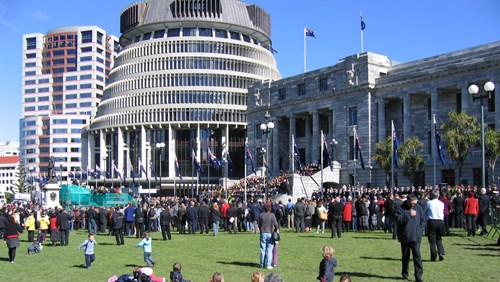
US-Iran Strikes: Iraq 2003 Comparison Misses Mark
On June 21, the United States launched airstrikes on three Iranian nuclear facilities – Fordow, Natanz and Isfahan – pounding deeply buried centrifuge sites with bunker-busting bombs .
Conducted jointly with Israel, the operation took place without formal congressional authorisation, drawing sharp criticism from lawmakers that it was unconstitutional and ” unlawful “.
Much of the political debate has centred on whether the US is being pulled into ” another Middle East war “.
Even US Vice President JD Vance understood the unease, stating :
These reactions have revived comparisons with George W. Bush’s 2003 invasion of Iraq: a Republican president launching military action on the basis of flimsy weapons of mass destruction (WMD) evidence .
Hauntingly familiar?
While the surface similarity is tempting, the comparison may in fact obscure more about President Donald Trump than it reveals.
In 2003, Bush ordered a full-scale invasion of Iraq based on flawed intelligence , claiming Iraqi dictator Saddam Hussein possessed WMDs. And while the war was extremely unpopular across the world, it did have bipartisan congressional support.
The invasion toppled Iraq’s regime in just a few weeks.
What followed was a brutal conflict and almost a decade of US occupation. The war triggered the rise of militant jihadism and a horrific sectarian conflict that reverberates today .
So far, Trump’s one-off strikes on Iran bear little resemblance to the 2003 Iraq intervention.
These were precision strikes within the context of a broader Iran-Israel war , designed to target Iran’s nuclear program.
And, so far, there appears to be little appetite for a full-scale military invasion or “boots on the ground”, and regime change seems unlikely despite some rumblings from both Trump and Israeli Prime Minister Benjamin Netanyahu.
Yet the comparison to Iraq persists, especially among audiences suspicious of repeated US military interventions in the Middle East. But poorly considered analogies carry costs.
For one, the Iraq comparison sheds little light on Trump’s foreign policy.
To better understand the recent strikes on Iran, we need to look at Trump’s broader foreign policy.
Much has been made of his “America first” mantra, a complex mix of prioritising domestic interests, questioning international agreements, and challenging traditional alliances.
Others, including Trump himself, have often touted his ” no war ” approach, pointing to large-scale military withdrawals from Afghanistan, Syria and Iraq,and the fact he had not started a new war.
But beyond this, Trump has increased US military spending and frequently used his office to conduct targeted strikes on adversaries – especially across the Middle East.
For example, in 2017 and 2018, Trump ordered airstrikes on a Syrian airbase and chemical weapons facilities. In both instances, he bypassed Congress and used precision air power to target weapons infrastructure without pursuing regime change.
Also, from 2017 to 2021, Trump authorised US support for the Saudi-led war in Yemen, enabling airstrikes that targeted militant cells but also led to mass civilian casualties .
Trump’s policy was the subject of intense bipartisan opposition, culminating in the first successful congressional invocation of the War Powers Resolution – though it was ultimately vetoed by Trump.
And in 2020, Trump launched a sequence of attacks on Iranian assets in Iraq. This included a drone strike that killed senior Iranian military commander Qassem Soleimani.
Again, these attacks were conducted without congressional support. The decision triggered intense bipartisan backlash and concerns about escalation without oversight.
While such attacks are not without precedent – think back to former US President Barack Obama’s intervention in Libya or Joe Biden’s targeting of terrorist assets – the scale and veracity of Trump’s attacks on the Middle East are much more useful as a framework to understanding the recent attacks on Iran than any reference to the 2003 Iraq war.
It is crucial to scrutinise any use of force. But while comparing the 2025 Iran strikes to Iraq in 2003 may be rhetorically powerful, it is analytically weak.
A better path is to situate these events within Trump’s broader political style.
He acts unilaterally and with near-complete impunity, disregarding traditional constraints and operating outside established norms and oversight.
This is just as true for attacks on foreign adversaries as it is for the domestic policy arena.
For example, Trump recently empowered agencies such as Immigration and Customs Enforcement (ICE) to operate with sweeping discretion in immigration enforcement, bypassing legal and judicial oversight.
Trump also uses policy as spectacle, designed to send shockwaves through the domestic or foreign arenas and project dominance to both friend and foe.
In this way, Trump’s dramatic attacks on Iran have some parallels to his unilateral imposition of tariffs on international trade. Both are abrupt, disruptive and framed as a demonstration of strength rather than a way to create a mutually beneficial solution.
Finally, Trump is more than willing to use force as an instrument of power rather than as a last resort. This is just as true for Iran as it is for the US people.
The recent deployment of US Marines to quell protests in Los Angeles reveals a similar impulse: military intervention as a first instinct in the absence of a broader strategy to foster peace.
To truly understand and respond to Trump’s Iran strikes, we need to move beyond sensationalist analogies and recognise a more dangerous reality. This is not the start of another Iraq; it’s the continuation of a presidency defined by impulsive power, unchecked force and a growing disdain for democratic constraint.
Benjamin Isakhan receives funding from the Australian Research Council and the Australian Department of Defence. The views expressed in this article do not reflect those of Government policy.


